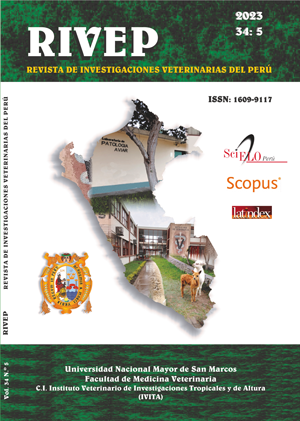Evaluation of animal welfare in three municipal slaughter plants in southwestern Ecuador
DOI:
https://doi.org/10.15381/rivep.v34i5.22199Keywords:
animal welfare, slaughter, stunning, indicators, cattleAbstract
The research was carried out in three municipal slaughter centers located in the southwest of Ecuador. Two weeks were used as a pre-experimental phase to validate the method, evaluating animal welfare indicators during entry into the access chute, knockout box, stunning and bleeding. Animal welfare was evaluated on direct, indirect, sensitivity and post mortem head inspection indicators. The sample consisted of 102 animals in Center A and 400 in centers B and C. In A (95.1%) the cattle were stung at least once on the sleeve, in B (41%) slips were observed, while in C (39.3%) vocalizations were recorded. Regarding the knockout box, 26.3% slipped (C), 15.7% fell, 20.6% vocalized (A), and 13.7% attempted to escape (A). The proportion of animals that fell at the first shot was 52.9% (A) and 88% (B and C) with an interval between stunning and bleeding of less than one minute of 4.9% (A), 0.8% (B) and 0.3% (C). Center A presented the most frequent sensitivity indicators after stunning such as rhythmic breathing (99.8%), corneal reflex (99.8%) and head elevation (98.3%). Post mortem head inspection reflected 17.6% (A), 51.0% (B) and 28.5% (C) of shot accuracy with respect to the ideal target less than 2 cm. In conclusion, the municipal slaughterhouses in the southwest of Ecuador presented poor animal welfare management, failing to comply with international standards, negatively affecting the welfare of cattle in the premortem, stunning and bleeding procedures.
Downloads
Downloads
Published
Issue
Section
License
Copyright (c) 2023 Deysi Guevara-Freire, Luciano Valle, Diana Avilés-Esquivel, Karen Villarroel, Joan Aguagallo

This work is licensed under a Creative Commons Attribution 4.0 International License.
AUTHORS RETAIN THEIR RIGHTS:
a. Authors retain their trade mark rights and patent, and also on any process or procedure described in the article.
b. Authors retain their right to share, copy, distribute, perform and publicly communicate their article (eg, to place their article in an institutional repository or publish it in a book), with an acknowledgment of its initial publication in the Revista de Investigaciones Veterinarias del Perú (RIVEP).
c. Authors retain theirs right to make a subsequent publication of their work, to use the article or any part thereof (eg a compilation of his papers, lecture notes, thesis, or a book), always indicating the source of publication (the originator of the work, journal, volume, number and date).










